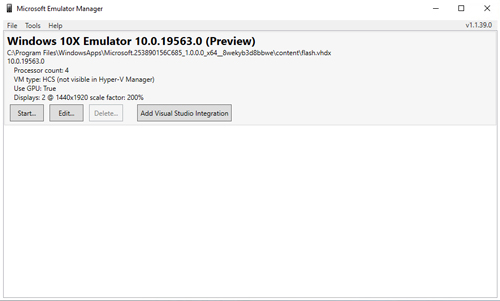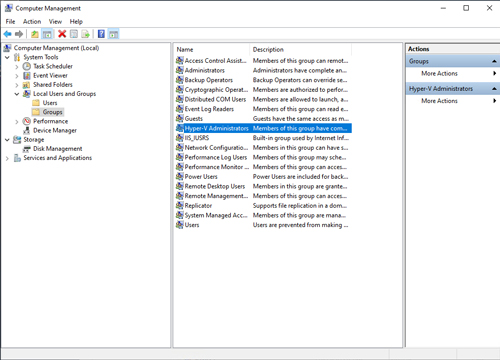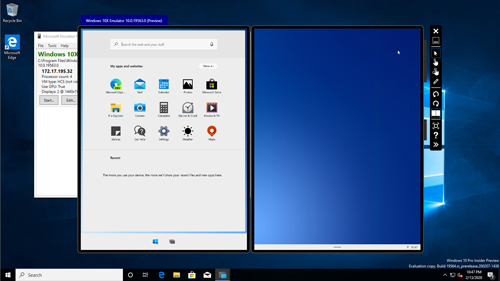Posey's Tips & Tricks
How To Install the Windows 10X Emulator
Earlier this month, Microsoft released a public preview of Windows 10X, a spinoff of the Windows 10 operating system that's designed to run on the forthcoming multiscreen Surface devices, dubbed the "Duo" and the "Neo." I am really excited to try out one of these next-generation Surface devices, and although the hardware isn't available today -- Microsoft is expected to launch both the Duo and the Neo around the 2020 holiday season -- the Windows 10X preview makes it possible to get a sneak-peek at the OS behind them.
Microsoft is making the Windows 10X preview available in the form of an emulator (much like it did for Windows Phone). You can find instructions and download links here. It is worth noting that Microsoft's instructions are primarily geared toward developers who need Visual Studio integration. As such, deploying the emulator is easier than that linked Web page might lead you to believe. At the same time, though, the process is a little bit different from importing a Hyper-V virtual machine (VM).
In order to use the emulator, you will need a Windows 10 machine that is running Windows Insider Preview Build 10.0.19555 or later. Recently, I wrote a column explaining how to become a Windows Insider and get the required preview. I also recommend that you run the Windows 10 preview build on a spare PC or inside a VM -- don't run it on the computer that you use on a daily basis. If you decide to use a VM, then you will need to enable nested virtualization so that you can run Hyper-V inside of your Windows 10 VM (Hyper-V is an emulator requirement). You can learn how to enable nested virtualization for a Windows 10 VM in another recent column here.
Before I tell you how to install the emulator, there are some system requirements that you need to be aware of. The main requirement for the host is that it runs Hyper-V. The VM will need at least four CPU cores and 15GB of free disk space (not counting the space consumed by the Windows 10 OS). It will also need at least 8GB of RAM. In addition, Microsoft recommends a dedicated video card and SSD storage.
With that said, installing the Windows 10X emulator is actually a really simple process. The first thing that you will need to do is to install this Microsoft Emulator found in the Microsoft Store. Just click Get, then click Install.
The other thing that you have to install is the Windows 10X emulator Image. Like the Microsoft Emulator, the Windows 10X emulator is found in the Microsoft Store here. It is worth noting, however, that the emulator is over 4GB in size, so it can take a while to download if you have a slow Internet connection.
When you launch the emulator, you are taken to a screen like the one that is shown in Figure 1. Unless you are a developer, there is no need to add Visual Studio integration. Just click the Start button.
 [Click on image for larger view.] Figure 1: When the emulator starts up, click the Start button.
[Click on image for larger view.] Figure 1: When the emulator starts up, click the Start button.
Hopefully, clicking the Start button will launch the emulator. If you have problems, then it is likely that you do not have the necessary permissions. The account that you are logged into Windows with must be an administrator on the local machine. The account must also have Hyper-V admin privileges.
If you need to add a user to the Hyper-V Administrators group, go to the Control Panel and enter Administrative Tools into the search box. When the Administrative Tools window opens, click Computer Management. From within the Computer Management console, go to System Tools | Local Users and Groups | Groups, as shown in Figure 2. Now, just double-click on the Hyper-V Administrators group and add your account to the group.
 [Click on image for larger view.] Figure 2: This is where you can go to access the Hyper-V Administrators group.
[Click on image for larger view.] Figure 2: This is where you can go to access the Hyper-V Administrators group.
Figure 3 shows what the Windows 10X emulator looks like. I have not yet had a chance to thoroughly explore the new operating system and its features, but stay tuned for a first-look column about it in the very near future.
 [Click on image for larger view.] Figure 3: This is the Windows10X emulator.
[Click on image for larger view.] Figure 3: This is the Windows10X emulator.
About the Author
Brien Posey is a 22-time Microsoft MVP with decades of IT experience. As a freelance writer, Posey has written thousands of articles and contributed to several dozen books on a wide variety of IT topics. Prior to going freelance, Posey was a CIO for a national chain of hospitals and health care facilities. He has also served as a network administrator for some of the country's largest insurance companies and for the Department of Defense at Fort Knox. In addition to his continued work in IT, Posey has spent the last several years actively training as a commercial scientist-astronaut candidate in preparation to fly on a mission to study polar mesospheric clouds from space. You can follow his spaceflight training on his Web site.